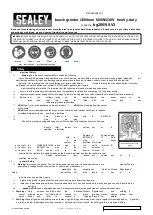
15
O R I G I N A L I N S T R U C T I O N S
GB
The disk must be used as intended. For example: do not grind with disks designed for cutting.
Abrasive disks for cutting
are designed for circumferential load, and the lateral forces applied to such a disk may destroy it.
Always use undamaged fixing disks, whose dimensions must be compatible with the grinding disk.
Adequate fixing disks
for the abrasive disk reduce the risk of damaging the grinding disk. The fixing disks for cutting disks may differ from the fixing disks
designed for grinding disks.
Do not use worn abrasive disks from bigger tools.
An abrasive disk of a bigger diameter is not adapted to a bigger rotational
speed of smaller tools and may break.
Warnings related to grinding with abrasive paper
Do not use discs with abrasive papers of an excessive size. While selecting the grinding wheel, follow the guidelines of
the manufacturer.
Abrasive paper which significantly exceeds the size of the disc may cause injuries and increases the risk of
seizure, tearing or rebounding towards the operator.
Warnings related to work with wire brushes
Be careful, since fragments of wires are ejected from the brush also during normal work. Do not overload the wires exert-
ing excessive force on the brush. The wires may easily perforate light clothes and/or the skin
.
If it is recommended to use guards while working with wire brushes, preclude any contact of the brush with the guard.
The diameter of the wire brush may increase due to the load and the centrifugal force.
INSTALLATION OF THE EQUIPMENT
Install the grinding disk guard
Place the disc guard on the cylindrical section of the body around the spindle and using screws or a clamping ring fix it so that the
guard is straight and safe. Position the grinding disk guard so that the unprotected area of the disk is as far as possible from the
hand which holds the handle. Do not ever work with the grinder without a properly installed disk guard!
The grinder is provided along with a protection which guarantees proper protection only while grinding with abrasive discs and
discs with abrasive paper as well as certain wire brushes. Once installed on the spindle, the disc must not protrude beyond the
edge of the protection. In case of any other permitted task, contact the manufacturer in order to purchase a guard for such kind
of work.
Installation of the additional handle
If required install the handle screwing it securely to the head of the tool.
USING ABRASIVE DISKS
ATTENTION!
Installation of the abrasive disks must be realised with the power supply off. Remove the plug of the cord of the
grinder from the socket
Installation of abrasive disks
Disconnect the tool. Remove the plug from the socket!
During installation make sure the edges A (IV) at the bottom spindle mandrel and the fixing disks align precisely.
Place the upper fixing disk on the spindle.
Place the abrasive disk on the spindle and the installed fixing disk.
Screw the lower fixing disk onto the spindle.
Press the spindle blockade and tighten the lower fastening disk with a spanner and release the blockade.
Insert the plug of the power supply cord of the tool into the socket, turn the grinder on and observe its operation without any load
for approximately one minute.
Remove the plug from the socket and make sure the disk is installed securely.
Position of the fixing disks
Please note that the discs may have different thickness in the area in which they are installed on the spindle.
Depending on the abrasive disks used - thin ones whose thickness does not exceed 3.2 mm or thick ones whose thickness
exceeds 3.2 mm) the position of the fixing disk differs (III). Do not use the discs thicker than 6 mm.
Removal of the abrasive disks
Turn the grinder off and remove the plug of the electric cord of the grinder from the mains socket.
Press the spindle blockade and unscrew the lower fixing disk using a spanner, and remove the abrasive disk from the spindle.
Clean the spindle and the fixing discs removing dust and other contamination generated during work.
Kinds of abrasive discs
For work with the grinder it is possible to use any grinding disc for angular grinders whose acceptable tangential velocity is at least
















































